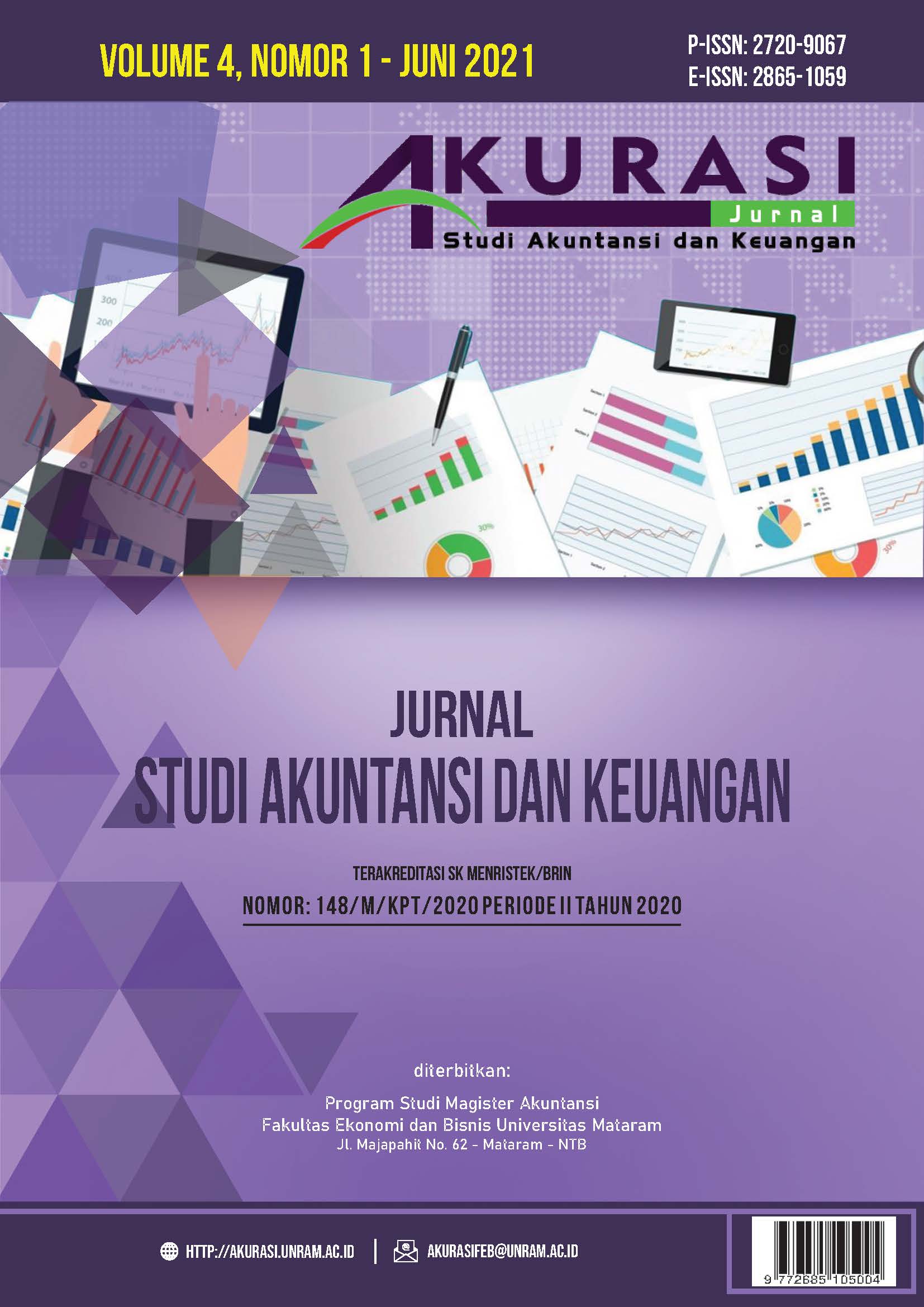Empirical Evidence of Asset Pricing Based on Single Index Model, Fama, and French Three and Five-Factor Models in Indonesia Stock Exchange
DOI:
https://doi.org/10.29303/akurasi.v4i1.82Keywords:
asset pricing, single index model, Fama and French three and five-factor model, risk, returnAbstract
This empirical test aims to estimate the beta parameters of the risk premium and other risk factors and compare the performance of the single-index model, Fama and Frech three and five-factor models. The sample used as the study object is companies in the property and real estate subsector with data collected from datastream Thomson Reuters from January 2014 to December 2018. The results are consistent with the previous studies that asset pricing using the Fama and French five-factor model can better explain stock returns than the other two models. The property and real estate subsector seems to provide a positive and statistically significant abnormal return, indicating that asset pricing with the three models is irrelevant to Indonesia. These results suggest that the stock market in Indonesia is still inefficient.
Downloads
References
Banz, R. W. (1981). The relationship between return and market value of common stocks. Journal of Financial Economics, 9(1), 3–18.
Black, S. W. (1976). Rational response to shocks in a dynamic model of capital asset pricing. The American Economic Review, 66(5), 767–779.
Bodie, Z., Kane, A., & Marcus, A. J. (2014). Investments (10th ed.). New York: McGraw-Hill Education.
Chiah, M., Chai, D., Zhong, A., & Li, S. (2016). A Better Model? An empirical investigation of the Fama–French five‐factor model in Australia. International Review of Finance, 16(4), 595–638. https://doi.org/10.1111/irfi.12099
Cox, S., & Britten, J. (2019). The Fama-French five-factor model: evidence from the Johannesburg Stock Exchange. Investment Analysts Journal, 48(3), 240–261. https://doi.org/10.1080/10293523.2019.1647982
Fama, E. F., & French, K. R. (2015). A five-factor asset pricing model. Journal of Financial Economics, 116, 1–22.
Fama, E. F., & French, K. R. (2017). International tests of a five-factor asset pricing model. Journal of Financial Economics, 123(3), 441–463. https://doi.org/10.1016/j.jfineco.2016.11.004
Fama, E., & French, K. (1992). The cross-section of expected stock returns. Journal of Finance, 47(2), 427–465. https://doi.org/10.2307/2329112
Fama, Eugene F., & French, K. R. (2018). Chosing Factors. Journal of Financial Economics, 128, 234–252.
Foye, J. (2018). A comprehensive test of the Fama-French five-factor model in emerging markets. Emerging Markets Review, 37, 199–222. https://doi.org/10.1016/j.ememar.2018.09.002
Harvey, C. R., Liu, Y., & Zhu, H. (2016). … and the cross-section of expected returns. The Review of Financial Studies, 29(1), 5–68.
Huang, T.-L. (2019). Is the Fama and French five-factor model robust in the Chinese stock market? Asia Pacific Management Review, 24(3), 278--289.
Lin, Q. (2017). Noisy prices and the Fama–French five-factor asset pricing model in China. Emerging Markets Review, 31, 141–163. https://doi.org/10.1016/j.ememar.2017.04.002 d
Lintner, J. (1965). The Valuation of Risk Assets and the Selection of Risky Investments in Stock Portfolios and Capital Budgets. Review of Economics and Statistics, 47(1), 13–37.
Markowitz, H. M. (1959). Portfolio selection: Efficient diversification of investments. John Wiley.
Novy-Marx, R. (2013). The other side of value: The gross profitability premium. Journal of Financial Economics, 108, 1–28.
Sharpe, W. F. (1964). Capital asset prices: A theory of market equilibrium under conditions of risk. The Journal of Finance, 19(3), 425–442. https://doi.org/10.1111/j.1540-6261.1964.tb02865.x
Sharpe, William F. (1963). A simplified model for portfolio analysis. Management Science, 9(2), 277–293.
Shih, Y.-C., Chen, S.-S., Lee, C.-F., & Chen, P.-J. (2014). The evolution of capital asset pricing models. Review of Quantitative Finance and Accounting, 42(3), 415–448.
Sutrisno, B., & Ekaputra, I. A. (2016). Uji Empiris Model Asset Pricing Lima Faktor Fama-French Di Indonesia. Jurnal Keuangan Dan Perbankan, 20(3), 343–357.
Titman, S., Wei, K. J., & Xie, F. (2004). Capital Investments and Stock Returns. Journal of Financial and Quantitative Analysis, 39(4), 677–700. https://doi.org/10.1017/S0022109000003173
Watanbe, A., Yu, Y., Yao, T., & Yu, T. (2013). The asset growth effect: insights from international equity markets. Journal of Financial Economics, 108, 529–563.
Downloads
Published
How to Cite
Issue
Section
License
Authors who publish in Akurasi: Jurnal Studi Akuntansi dan Keuangan agree to the following terms:
- Authors retain the copyright of their articles.
- Authors grant Akurasi: Jurnal Studi Akuntansi dan Keuangan the right of first publication.
- Articles are licensed under the Creative Commons Attribution-ShareAlike 4.0 International License (CC BY-SA 4.0).
- This license allows anyone to copy, distribute, display, and adapt the articles for any purpose, including commercial use, as long as proper credit is given to the author(s) and the source, and derivative works are distributed under the same license.
- All published articles are open access and may be used for educational, research, and scientific purposes.
License: 
This work is licensed under a Creative Commons Attribution-ShareAlike 4.0 International License.







